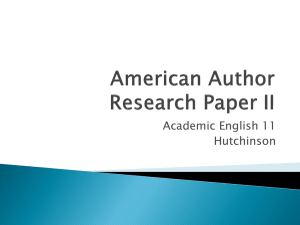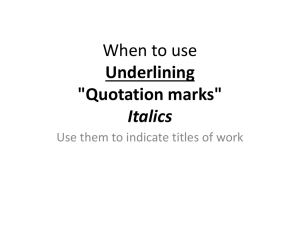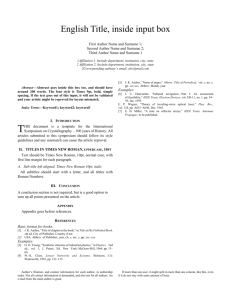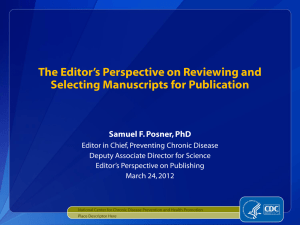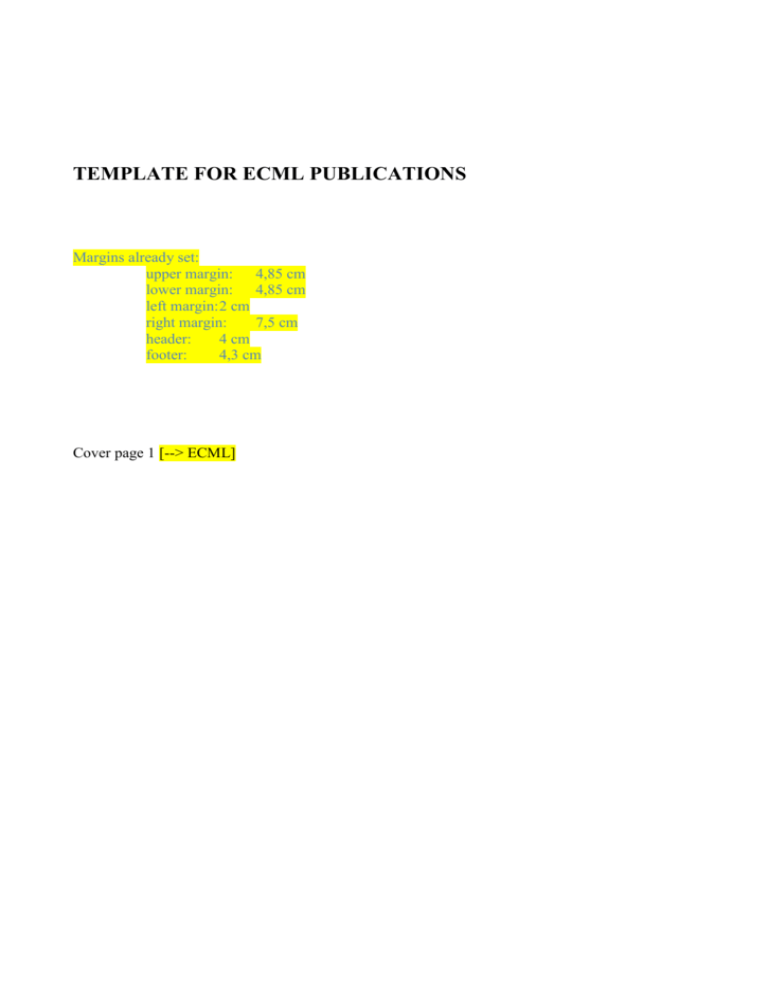
TEMPLATE FOR ECML PUBLICATIONS
Margins already set:
upper margin: 4,85 cm
lower margin: 4,85 cm
left margin: 2 cm
right margin:
7,5 cm
header:
4 cm
footer:
4,3 cm
Cover page 1 [--> ECML]
Cover page 2 [--> ECML]
odd page
Title of the publication
even page
Acknowledgements
Acknowledgements addressed to staff members, experts, trainees
or other people who contributed to the preparation of a manuscript
should appear on the imprint page (page 2, the verso of the title
page, which also includes all the legal notices).
Example of an acknowledgement:
The author is particularly grateful to John Smith, Doctor of Law
and Head of the Committee on Culture, Science, Education and
Media of the Parliamentary Assembly of the Council of Europe. He
also wishes to thank the Council of Europe directorates for
correcting the manuscript of this publication.
[--> ECML]
French / German edition:
Title
ISBN ...
The opinions expressed in this work are the responsibility of the authors and do
not necessarily reflect the official policy of the Council of Europe.
All rights reserved. No part of this publicaiton may be translated, reproduced or
transmitted, in any form or by any means, electronic (CD-Rom, Internet, etc.) or
mechanical, including photocopying, recording or any infrmation storage or
retrieval system, without prior permission in writing from the Directorate of
Communication (F-67075 Strasbourg Cedex or publishing@coe.int).
Cover: ...
Illustrations: ...
Layout: ...
Council of Europe Publishing
F-67075 Strasbourg Cedex
http://book.coe.int
ISBN ...
@ Council of Europe, December 2014
Printed in Austria
If relevant - Any dedication should appear on this page.
Example of a dedication:
In memory of John Smith (1930-1990).
odd page
Title of the publication
7
even page
8
odd page
Title of the publication
Contents
[--> ECML will create an automatic table of contents once the
publication is formatted]
9
even page
10
odd page
Foreword
11
even page
12
odd page
Heading formats:
Chapter: Times New Roman, bold, 14 pt
Heading 1: Times New Roman, bold, 12 pt
Level 2: Times New Roman, bold italics, 12 pt
Level 3: Times New Roman, bold, italics, 12 pt
Level 4: Times New Roman, italics, 12 pt
Level 5: Times New Roman, indented, italics, 12 pt
Examples:
Chapter 1: Format
1. Cover pages
The following rules apply to covers:
avoid any overlap or confusion between the title of the work
(the most important element) and any other written text
(slogans, project names, series title, etc.);
the Council of Europe logo must appear on the front cover;
with the exception of statutory publications or co-editions,
the cover should bear no other logos. Sectorial logos or
associations of logos may appear on the back cover or on the
title page (first page) of the publication.
3.1. Front cover page: names of the authors
Please indicate in which order the names of the authors should
appear on the cover page.
13
3.2. Back cover page: mandatory elements and blurb
3.2.1. Back cover: mandatory elements
The back cover must include the following elements:
a summary or short presentation of the book (not more than 200
words - see para. 7.2.1);
a presentation of the Council of Europe (standard text, regularly
updated and available from the Organisation);
the Internet addresses of the Council of Europe website
(www.coe.int) and the ECML website (www.ecml.at).
14
even page
15
odd page
Bibliography
Presentation
The bibliography should be presented in accordance with the
Council of Europe’s typography rules:
Entries should be in this order:
1) Author (date), 2) Title, 3) Publisher, 4) Place of
publication.
Commas separate each piece of information and a full stop closes
the reference.
Example:
Koppy E. D. (2010), Proofreading, Tallulah Press, Tallulah.
Author (date)
The author’s surname comes first, then his/her initial(s). There is
no comma between the author’s surname and initial(s) or the date.
Initials take points and a space between each if more than one.
List authors/editors with compound names according to the first of
their surnames.
For names with prefixes (de, van, von, etc.), list according to the
surname and put the prefix after the initial, in parentheses:
Pozo Martín F.
Boer-Buquicchio M. (de).
If two or more references have the same author/editor and
publication year, each should have a lower-case letter (roman type)
added to the year to distinguish them.
16
Examples:
(Smithers 2000)
(Butcher 2003a)
(Butcher 2003b: 251-8).
Title
Titles of books and periodicals should be in italics (no
quotation marks), with initial capitals on the first word of the
title and on proper nouns only.
Entries are listed in alphabetical order by author or editor
(including institutional works).
Put multiple works by the same author(s)/editor(s) in date
order (earliest first). Then put in date order any works where
the same author/editor is the first named (of two or more);
these should be cited as “[Author] et al.”. Edited works may
be (but need not be) interfiled with authored works.
Citation of a complete work
The bibliographical list comes at the back of the work, under the
heading “References” or “Works cited” (not “Bibliography”).
The author’s surname comes first, then his/her initial(s). Leave a
space between these two, but no punctuation. Initials take points
and a space between each if more than one. Entries should be
ordered in the following manner:
Author (date), Title, Publisher, Place of publication.
For example:
Butcher J. (2003), Copy-editing: The Cambridge handbook,
Cambridge University Press, Cambridge.
17
If a passage is quoted, the relevant page number must be indicated:
Doe J. (1962), The day the earth stood still, Random House,
New York, p. 23.
Note that there is no comma between the author’s surname and
initial/given name. Commas otherwise separate each piece of
information.
The work is part of a series
Put series titles (capitals on all significant words) and the number
in the series after the title:
Author (date), Title, Series Title No. in series, Publisher,
Place of publication.
Evermore R. (2012), Webliography, Editorial Studies No. 7,
Ps & Qs Publishing, London.
Article or chapter in a larger work
For an article or chapter in a larger work, respect the following
order
(“in”
roman
type):
Author (date), “Title”, in Author/editor (year), Title of work,
Publisher, Place of publication.
Hamm E. B. (1980), “English breakfast returns”, in Sauce H.
P. (ed.), Cooking nation, Unwin, London.
Article in a periodical or journal
Author (date), “Title”, Title of Periodical number, page numbers.
Smith J. (1990), “Culinary upstarts”, Revolutionary Cooking
No. 43, pp. 151-67.
Publisher details may be added after the page numbers if
known.
18
Book and article titles in bibliographies and reference lists should
have initial capitals on the first word of the title and on proper
nouns only, but not on the other words. The titles of newspapers
and journals should keep the capitals of their registered name,
however.
Do not change initial capitals for the foreign-language titles of
books, organisations, etc., as they may not follow the same rules as
English titles. Check titles on the Internet or with a native speaker
if in doubt.
Multi-author works
Up to three authors – put the names as they appear on the cover of
the work:
Witherspoon M. and Merry P. (1924), Ersatz upbringing,
Pingu Publishing, Cheswick.
More than three authors – first name to appear on the cover of the
work, followed by “et al.”:
Irvine Q. et al. (2007), Lopsided geometry, Fiddlers,
Tottenham.
Editors, translators
In compilations and compendiums, the editor’s name appears first,
followed by “(ed.)” (plural “(eds)” – no full stop):
Wedley
H.
and
Stanley
P.
(eds)
(2010),
Antidisestablishmentarianism today, O’Reilly, Cork.
To indicate a translator’s name, add “(tr.)” after the title, followed
by the name:
Rubikk E. (1990), Life in a cube, (tr.) Moore S., Lubrik,
Sussex.
19
Editions
As necessary, put the edition number in parentheses after the title,
no comma before: “(2nd edn)”:
Wise G. (2012), Penny wise, euro foolish (9th edn), Bankish,
London.
Foreign language titles and translations
Works should be cited as referred to by the author. If the original
language is not English, there are two possibilities: either a
reference to an English translation, if available, can be given in
addition, or a translation of the title in English can be given in
roman min. caps, in square brackets:
Kastanji L. (1983), Életem, Kiado, Budapest; Engl.
translation as My life, Rumhouse, Oxford, 2001.
Rugen I. (1999), Ferien bei mir [Holidays at my place],
Stumpf, Berlin.
Conversely, it may be useful to give the original-language edition if
the main reference is to a translation:
Nonante J. D. (2000), Insignificant social diseases, Nailer,
New York [French orig. Maladies sociales insignifiantes,
Brouette, Paris, 1989].
Reports by the Council of Europe or other
international organisations
The full document reference number must be given along with as
much other information as possible, since these documents can
sometimes be difficult to locate (for example, specify the project or
department concerned).
Council of Europe (2002), “Report on the agenda-setting
workshop on e-governance” (Doc. IP1 (2002) 18).
20
Websites
References to websites might contain any of the information given
above. Follow the basic template chosen, but add the URL
(Universal Resource Locator, or Internet address), preceded by “,
available at”, and provide the date accessed. If the URL begins
with “www.”, leave off the preceding “http://”:
Hollo Z. (2006), National anthems, national fruits, available
at www.homelanddo.org/NANF.html, accessed 1 October
2007.
Avoid long URLs by providing the home page URL and the rubric
to visit. Be as specific as possible because the Internet is constantly
changing. Avoid references such as: “John Doe has written an
article. It can be found at www.johndoe.com/article.html”. If the
link changes, the reference is useless, but if readers have the exact
title or reference of a document, they have a good chance of finding
it elsewhere.
21
even page
Note about the author(s) / contributor(s)
Please give a brief presentation of the author(s) of the book (10-15
lines): who are they, what are their fields of expertise, function(s),
institutions...
This contribution will be inserted at the end of the book (max. 1-2
pages).
22
odd page
23
even page
24
odd page
[--> ECML]
Cover page 3 (blank)
25
even page
[--> ECML]
Cover page 4
Title of the publication
Blurb
Council of Europe logo
www.coe.int
The Council of Europe has 47 member states, covering virtually the
entire continent of Europe. It seeks to develop common democratic
and legal principles based on the European Convention on Human
Rights and other reference texts on the protection of individuals.
Ever since it was founded in 1949, in the aftermath of the Second
World War, the Council of Europe has symbolised reconciliation.
ISBN
Barcode
€.../US$...
http://book.coe.int
Council of Europe Publishing
26



